1999 TOYOTA CAMRY engine oil
[x] Cancel search: engine oilPage 4310 of 4592
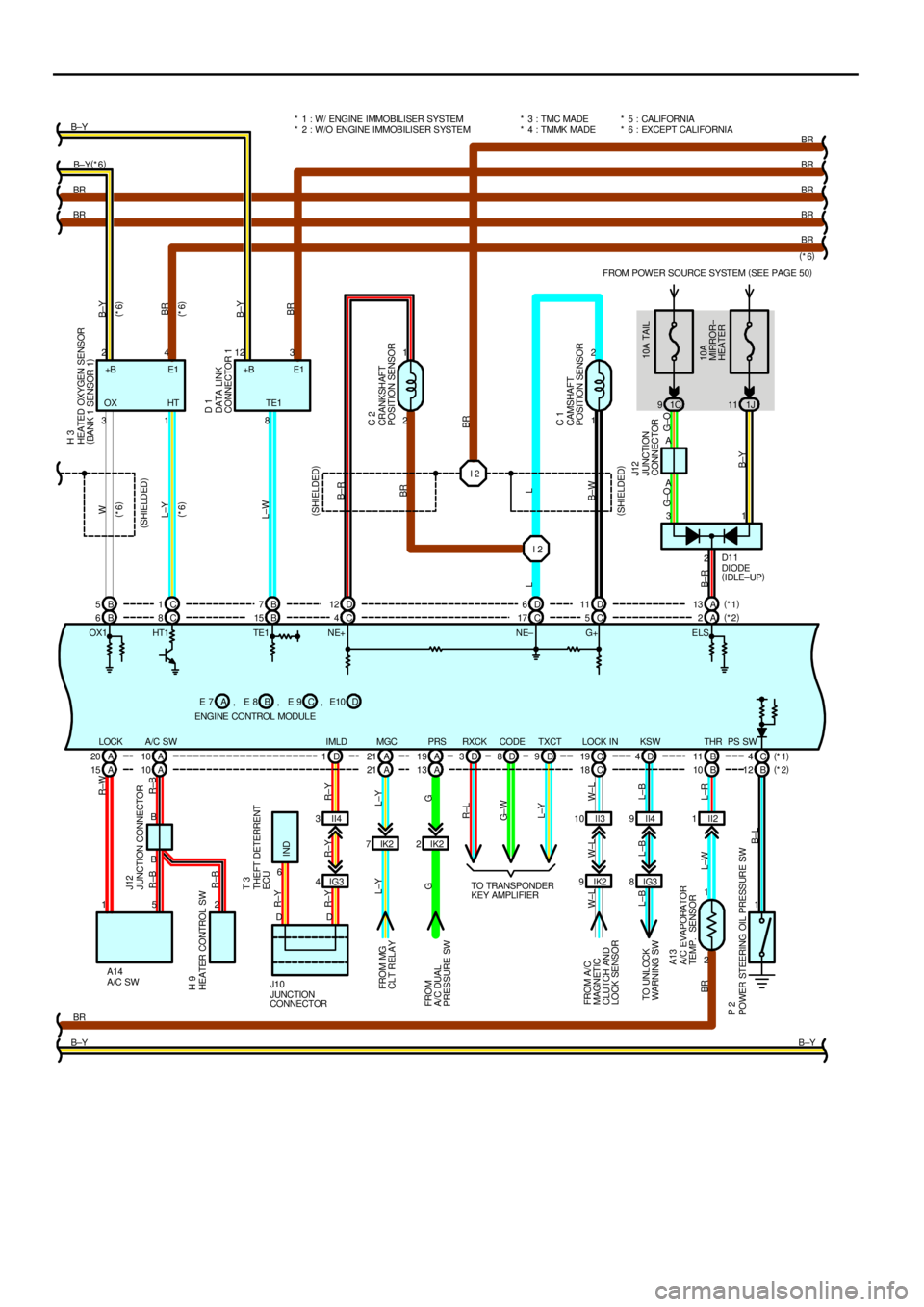
FROM POWER SOURCE SYSTEM (
SEE PAGE 50)
1C 91J11
1 2
2 1
IK2 7IK22
IK2 9II3 10 II21
1 I 2 I 2
A 10 A 20 A21 A19 C19 B11 C4 B 6C8B15 C4C17 C5A2
2 1 B8 1 3
2 A
B4 2123
A
1 3
2 5 1
BR
B±YBR BRB±Y(
*6) B±Y
BR
BR
BR
BR
BR
B±Y PS SW THR LOCK IN PRS MGC TE1
A/C SW LOCK
B±LL±R L±W BRW±L W±L W±LG L±Y
G L±YR±BR±B R±W
R±BW
L±Y
L±W
B±R
BR
L
B±W
G±O G±O
B±YB±Y
BR
B±Y
BR
OX1 HT1 TE1 NE+ NE± G+ E LSE1 +B
10A TAIL
10A
MIRROR±
HEATER (
SHIELDED)
(
SHIELDED) (
SHIELDED)
(
*6) (
*6)(
*6)
(
*6)
L
B±R
(
*6)
DIODE
(
IDLE±UP)
HEATED OXYGEN SENSOR
(
BANK 1 SENSOR 1)
DATA LINK
CONNECTOR 1
CRANKSHAFT
POSITION SENSOR
CAMSHAFT
POSITION SENSOR
JUNCTION
CONNECTORH 3
D 1
C 2
C 1
J12
D11
JUNCTION CONNECTOR
A/C SWHEATER CONTROL SW
A/C EVAPORATOR
TEMP. SENSOR
POWER STEERING OIL PRESSURE SWFROM MG
CLT RELAY
FROM
A/C DUAL
PRESSURE SW
FROM A/ C
MAGNETIC
CLUTCH AND
LOCK SENSORJ12
A13
P 2H 9
A14* 5 : CALIFORNIA
* 6 : EXCEPT CALIFORNIA
BR
ENGINE CONTROL MODULEB E 7 E 8ACE 9 +B E1
OX HT* 1 : W/ ENGINE IMMOBILISER SYSTEM
* 2 : W/O ENGINE IMMOBILISER SYSTEM
, , DE10 , B 5C1B7D12 D6D11 A13(
*1)
(
*2)
IG3 8D 4KSW
L±B L±B L±B
TO UNLOCK
WARN ING SW
A 10 A 15 A21 A13 C18 B10 B12
IG3 4II4 3D 1IMLD
R±Y R±Y R±Y
6
IND R±YTHEFT DETERRENT
ECU T 3
(
*1)
(
*2) D 3D8D9TXCT CODE RXCK
R±L
G± W
L±Y
TO TRANSPONDER
KEY AMPLIFIER
DD
J10
JUNCTION
CONNECTORII4 9 * 3 : TMC MADE
* 4 : TMMK MADE
Page 4319 of 4592
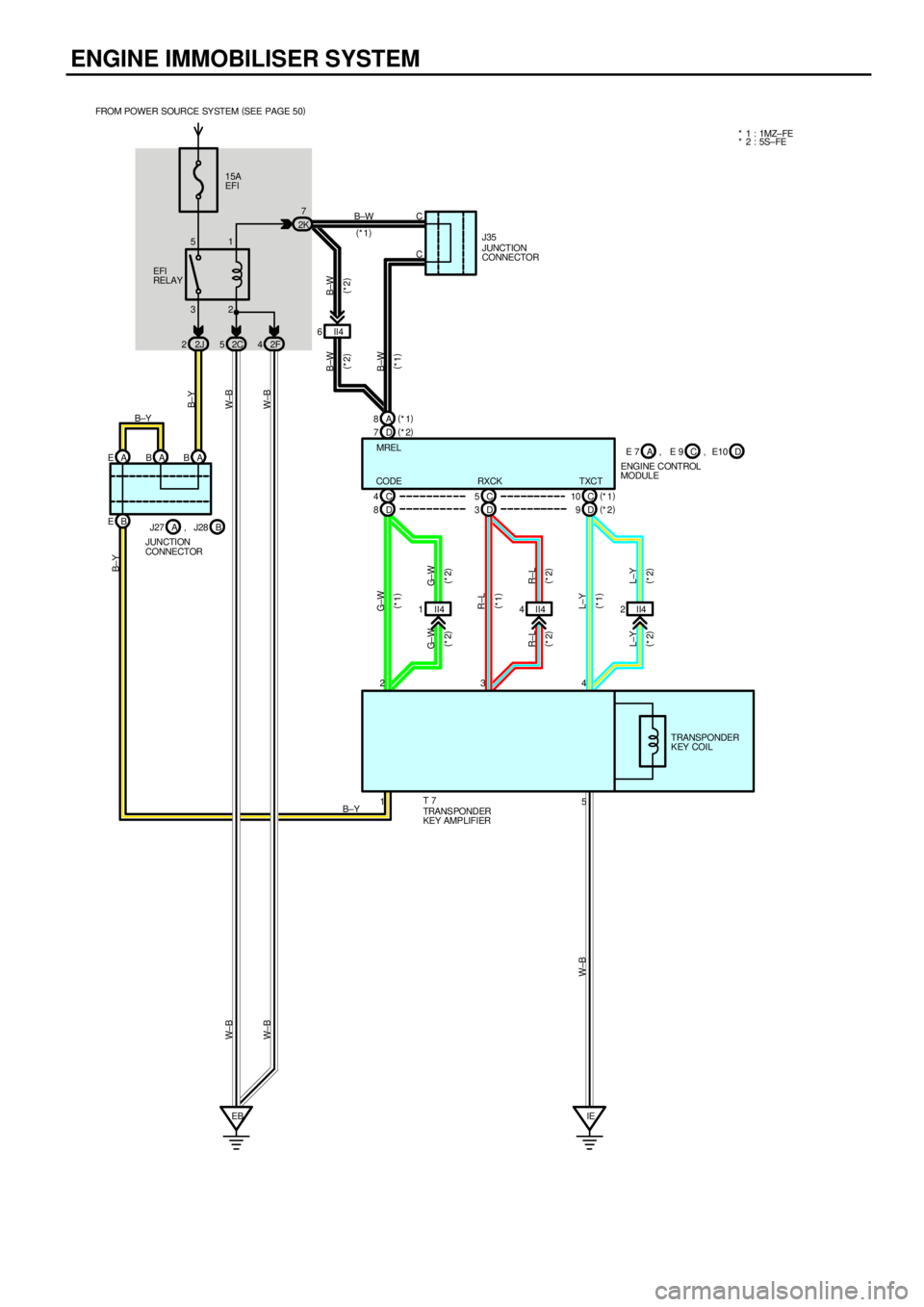
ENGINE IMMOBILISER SYSTEM
15A
EFI
32 51
2J 22C52F42K7
II4 6
D 7(
*2) A 8(
*1)
D 8C 4
D 3C 5
D 9(
*2) C 10(
*1)
II4 1 II44II42 B EA EAB A B
EBIE B±W
(
*1)
B±W
(
*2) B±W
(
*2)
B±W
(
*1) W±B
W±BB±Y
G± W
(
*2)
R±L
(
*2)
L±Y
(
*2) L±Y
(
*2) R±L
(
*2) G± W
(
*2)G±W
(
*1)
W±B
CODE RXCK TXCTMREL FROM POWER SOURCE SY STEM (
SEE PAGE 50)
EFI
RELAY
B±Y
L±Y
(
*1) R±L
(
*1)
E 7
ENGINE CONTROL
MODULEC A, E 9 D, E10
B±Y
J27
JUNCTION
CONNECTORB A, J28
5 1 234
B±YTRANSPONDER
KEY COIL
TRANS PONDER
KEY AMPLIFIER T 7
W± B W± B
* 1 : 1MZ± FE
* 2 : 5S±FE
JUNCTION
CONNECTOR J35 C
C
Page 4329 of 4592

HEADLIGHT (w/ DAYTIME RUNNING LIGHT)
The current from the FL MAIN is always flowing from the MAIN fuse to HEAD relay (Coil side) to TERMINAL H±LP of the
daytime running light relay (Main), from DOME fuse to TERMINAL +B of the daytime running light relay (Main) and from the
ALT fuse to Taillight relay (Coil side) to TERMINAL TAIL (TMMK Made) of the daytime running light relay (Main).
When the ignition SW is turned on, the current flowing through the GAUGE fuse flows to TERMINAL IG of the daytime
running light relay (Main).
1. DAYTIME RUNNING LIGHT OPERATION
When the engine is started, voltage generated at TERMINAL L of the generator is applied to TERMINAL CHG± of the
daytime running light relay (Main). If the parking brake lever is pulled up (Parking brake SW on) at this time, the relay is not
activated so the daytime running light system does not operate. If the parking brake lever is then released (Parking brake
SW off), a signal is input to TERMINAL PKB of the relay.
This activates the daytime running light relay (Main) and the HEAD relay is turned to on, so the current flows from the MAIN
fuse to the HEAD relay (Point side) to TERMINAL 1 of the DIM relay to TERMINAL 4 to H±LP LH (LWR), H±LP RH (LWR)
fuses to TERMINAL 1 of the headlights to TERMINAL 3 to TERMINAL 1 of the daytime running light resistor to TERMINAL 2
to GROUND, causing the headlights to light up (Headlights light up dimmer than normal brightness.). Once the daytime
running light system operates and the headlights light up, the headlights remain on even if the parking brake lever is pulled
up (Parking brake SW on).
If the engine stalls and the ignition SW remains on, the headlights remain light up even through current is no longer output
from TERMINAL L of the generator. If the ignition SW is then turned off, the headlights go off.
If the engine is started with the parking brake lever released (Parking brake SW off), the daytime running light system
operates and headlights light up when the engine starts.
2. HEADLIGHT OPERATION
When the light control SW is switched to HEAD position and the dimmer SW is set to LOW position, causing the daytime
running light relay (Main) and the HEAD relay to turn on, so the current flows from the MAIN fuse to HEAD relay (Point side)
to DRL NO.2 fuse to TERMINAL 3 of the DRL NO.4 relay to TERMINAL 4 to TERMINAL H±ON of the daytime running light
relay (Main) to TERMINAL H to TERMINAL 3 of the integration relay to TERMINAL 4 to TERMINAL 13 of the light control
SW to TERMINAL 16 to GROUND, activating the DRL. NO.4 relay. The current to HEAD relay (Point side) then flows to
TERMINAL 1 of the DIM relay to TERMINAL 4 to H±LP LH (LWR), H±LP RH (LWR) fuses to TERMINAL 1 of the headlights
to TERMINAL 3 to TERMINAL 1 of the DRL NO.4 relay to TERMINAL 2 to GROUND, causing the headlights to light up at
normal intensity.
When the light control SW is switched to HEAD position and the dimmer SW is set to HIGH position, the signal from the
dimmer SW is input to the daytime running light relay (Main). This activates the daytime running light relay (Main) and the
HEAD relay is turned on, so the current flows from the MAIN fuse to HEAD relay (Point side) to TERMINAL 1 of the DIM
relay to TERMINAL 3 to TERMINAL DIM of the daytime running light relay (Main), activating the DIM relay. This causes
current to flow from TERMINAL 1 of the DIM relay to TERMINAL 2 to HEAD LH (UPR), HEAD RH (UPR) fuses to TERMINAL
2 of the headlights to TERMINAL 3 to TERMINAL 1 of the DRL NO.4 relay to TERMINAL 2 to GROUND, causing the
headlights to light up at high beam and the high beam indicator light to light up.
When the dimmer SW is switched to FLASH position, the signal from the dimmer SW is input to the daytime running light
relay (Main). This activates the daytime running light relay (Main) and the HEAD relay is turned on, so the current flows from
the MAIN fuse to HEAD relay (Point side) to DRL NO.2 fuse to TERMINAL 3 of the DRL NO.4 relay to TERMINAL 4 to
TERMINAL H±ON of the daytime running light relay (Main) to TERMINAL H to TERMINAL 8 of the dimmer SW to
TERMINAL 16 to GROUND, activating the DRL NO.4 relay. At the same time, the current flows from the TERMINAL 1 of the
DIM relay to TERMINAL 3 to TERMINAL DIM of the daytime running light relay (Main), activating the DIM relay, and also
flows from the HEAD LH (UPR), HEAD RH (UPR) fuses to TERMINAL 2 of the headlights to TERMINAL 3 to TERMINAL 1 of
the DRL NO.4 relay to TERMINAL 2 to GROUND, causing the headlights to light up at high beam and the high beam
indicator light to light up.
SYSTEM OUTLINE
Page 4330 of 4592
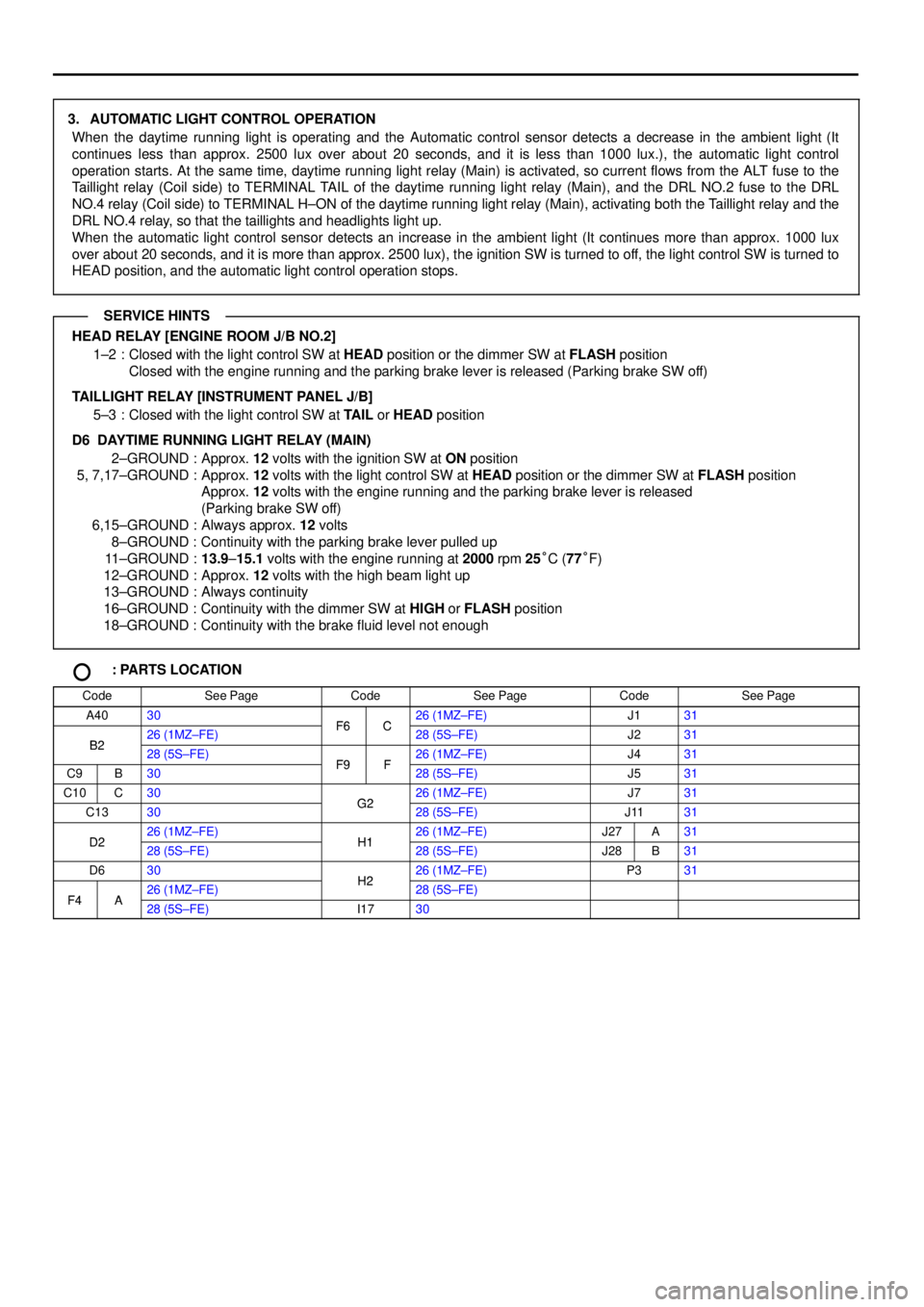
3. AUTOMATIC LIGHT CONTROL OPERATION
When the daytime running light is operating and the Automatic control sensor detects a decrease in the ambient light (It
continues less than approx. 2500 lux over about 20 seconds, and it is less than 1000 lux.), the automatic light control
operation starts. At the same time, daytime running light relay (Main) is activated, so current flows from the ALT fuse to the
Taillight relay (Coil side) to TERMINAL TAIL of the daytime running light relay (Main), and the DRL NO.2 fuse to the DRL
NO.4 relay (Coil side) to TERMINAL H±ON of the daytime running light relay (Main), activating both the Taillight relay and the
DRL NO.4 relay, so that the taillights and headlights light up.
When the automatic light control sensor detects an increase in the ambient light (It continues more than approx. 1000 lux
over about 20 seconds, and it is more than approx. 2500 lux), the ignition SW is turned to off, the light control SW is turned to
HEAD position, and the automatic light control operation stops.
HEAD RELAY [ENGINE ROOM J/B NO.2]
1±2 : Closed with the light control SW at HEAD position or the dimmer SW at FLASH position
Closed with the engine running and the parking brake lever is released (Parking brake SW off)
TAILLIGHT RELAY [INSTRUMENT PANEL J/B]
5±3 : Closed with the light control SW at TAIL or HEAD position
D6 DAYTIME RUNNING LIGHT RELAY (MAIN)
2±GROUND : Approx. 12 volts with the ignition SW at ON position
5, 7,17±GROUND : Approx. 12 volts with the light control SW at HEAD position or the dimmer SW at FLASH position
Approx. 12 volts with the engine running and the parking brake lever is released
(Parking brake SW off)
6,15±GROUND : Always approx. 12 volts
8±GROUND : Continuity with the parking brake lever pulled up
11±GROUND :13.9±15.1 volts with the engine running at 2000 rpm 25°C (77°F)
12±GROUND : Approx. 12 volts with the high beam light up
13±GROUND : Always continuity
16±GROUND : Continuity with the dimmer SW at HIGH or FLASH position
18±GROUND : Continuity with the brake fluid level not enough
: PARTS LOCATION
CodeSee PageCodeSee PageCodeSee Page
A4030F6C26 (1MZ±FE)J131
B226 (1MZ±FE)F6C28 (5S±FE)J231B228 (5S±FE)F9F26 (1MZ±FE)J431
C9B30F9F28 (5S±FE)J531
C10C30G226 (1MZ±FE)J731
C1330G228 (5S±FE)J1131
D226 (1MZ±FE)H126 (1MZ±FE)J27A31D228 (5S±FE)H128 (5S±FE)J28B31
D630H226 (1MZ±FE)P331
F4A26 (1MZ±FE)H228 (5S±FE)F4A28 (5S±FE)I1730
SERVICE HINTS
Page 4336 of 4592
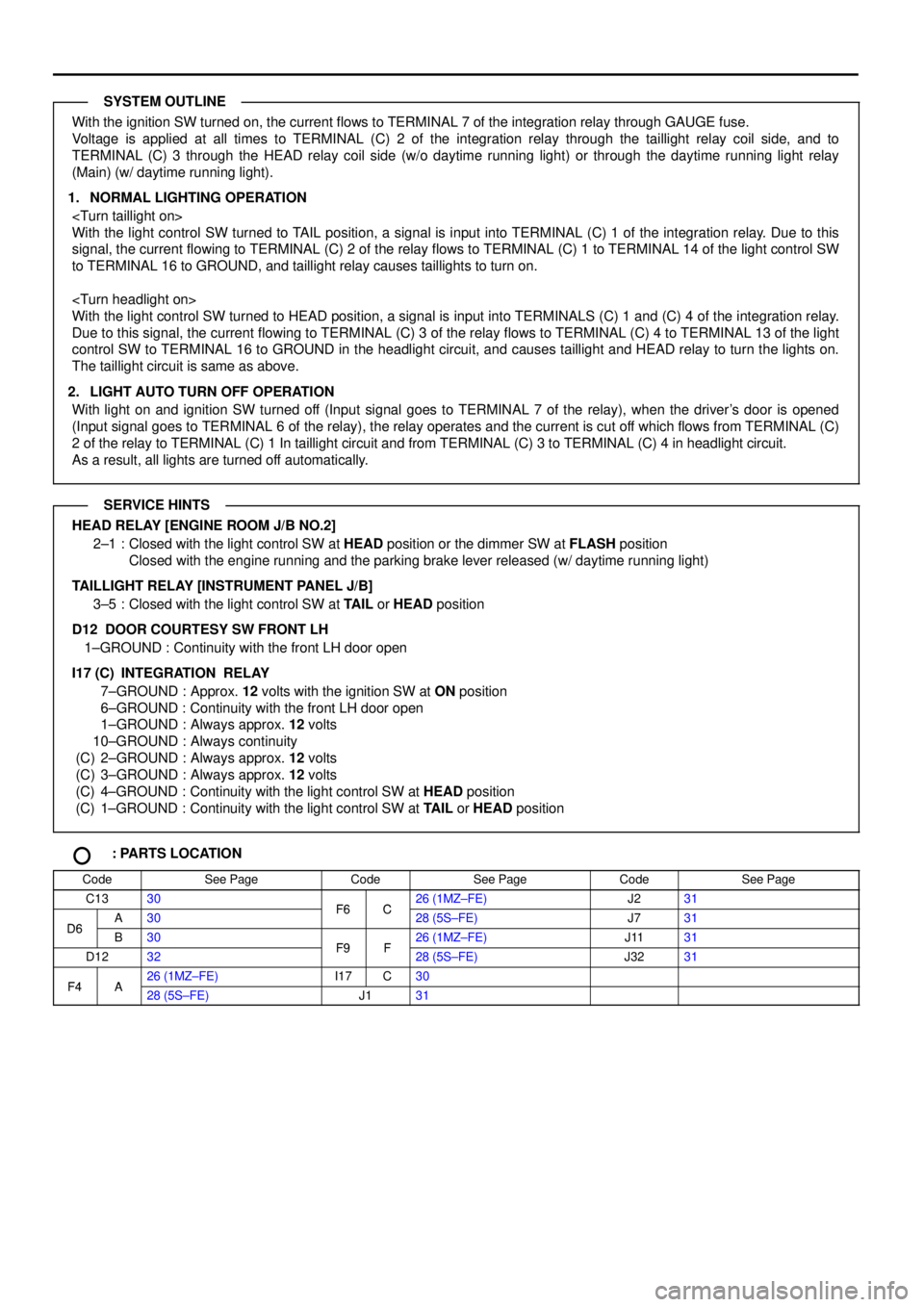
With the ignition SW turned on, the current flows to TERMINAL 7 of the integration relay through GAUGE fuse.
Voltage is applied at all times to TERMINAL (C) 2 of the integration relay through the taillight relay coil side, and to
TERMINAL (C) 3 through the HEAD relay coil side (w/o daytime running light) or through the daytime running light relay
(Main) (w/ daytime running light).
1. NORMAL LIGHTING OPERATION
With the light control SW turned to TAIL position, a signal is input into TERMINAL (C) 1 of the integration relay. Due to this
signal, the current flowing to TERMINAL (C) 2 of the relay flows to TERMINAL (C) 1 to TERMINAL 14 of the light control SW
to TERMINAL 16 to GROUND, and taillight relay causes taillights to turn on.
With the light control SW turned to HEAD position, a signal is input into TERMINALS (C) 1 and (C) 4 of the integration relay.
Due to this signal, the current flowing to TERMINAL (C) 3 of the relay flows to TERMINAL (C) 4 to TERMINAL 13 of the light
control SW to TERMINAL 16 to GROUND in the headlight circuit, and causes taillight and HEAD relay to turn the lights on.
The taillight circuit is same as above.
2. LIGHT AUTO TURN OFF OPERATION
With light on and ignition SW turned off (Input signal goes to TERMINAL 7 of the relay), when the driver's door is opened
(Input signal goes to TERMINAL 6 of the relay), the relay operates and the current is cut off which flows from TERMINAL (C)
2 of the relay to TERMINAL (C) 1 In taillight circuit and from TERMINAL (C) 3 to TERMINAL (C) 4 in headlight circuit.
As a result, all lights are turned off automatically.
HEAD RELAY [ENGINE ROOM J/B NO.2]
2±1 : Closed with the light control SW at HEAD position or the dimmer SW at FLASH position
Closed with the engine running and the parking brake lever released (w/ daytime running light)
TAILLIGHT RELAY [INSTRUMENT PANEL J/B]
3±5 : Closed with the light control SW at TAIL or HEAD position
D12 DOOR COURTESY SW FRONT LH
1±GROUND : Continuity with the front LH door open
I17 (C)
INTEGRATION RELAY
7±GROUND : Approx. 12 volts with the ignition SW at ON position
6±GROUND : Continuity with the front LH door open
1±GROUND : Always approx. 12 volts
10±GROUND : Always continuity
(C) 2±GROUND : Always approx. 12 volts
(C) 3±GROUND : Always approx. 12 volts
(C) 4±GROUND : Continuity with the light control SW at HEAD position
(C) 1±GROUND : Continuity with the light control SW at TAIL or HEAD position
: PARTS LOCATION
CodeSee PageCodeSee PageCodeSee Page
C1330F6C26 (1MZ±FE)J231
D6A30F6C28 (5S±FE)J731D6B30F9F26 (1MZ±FE)J1131
D1232F9F28 (5S±FE)J3231
F4A26 (1MZ±FE)I17C30F4A28 (5S±FE)J131
SYSTEM OUTLINE
SERVICE HINTS
Page 4509 of 4592
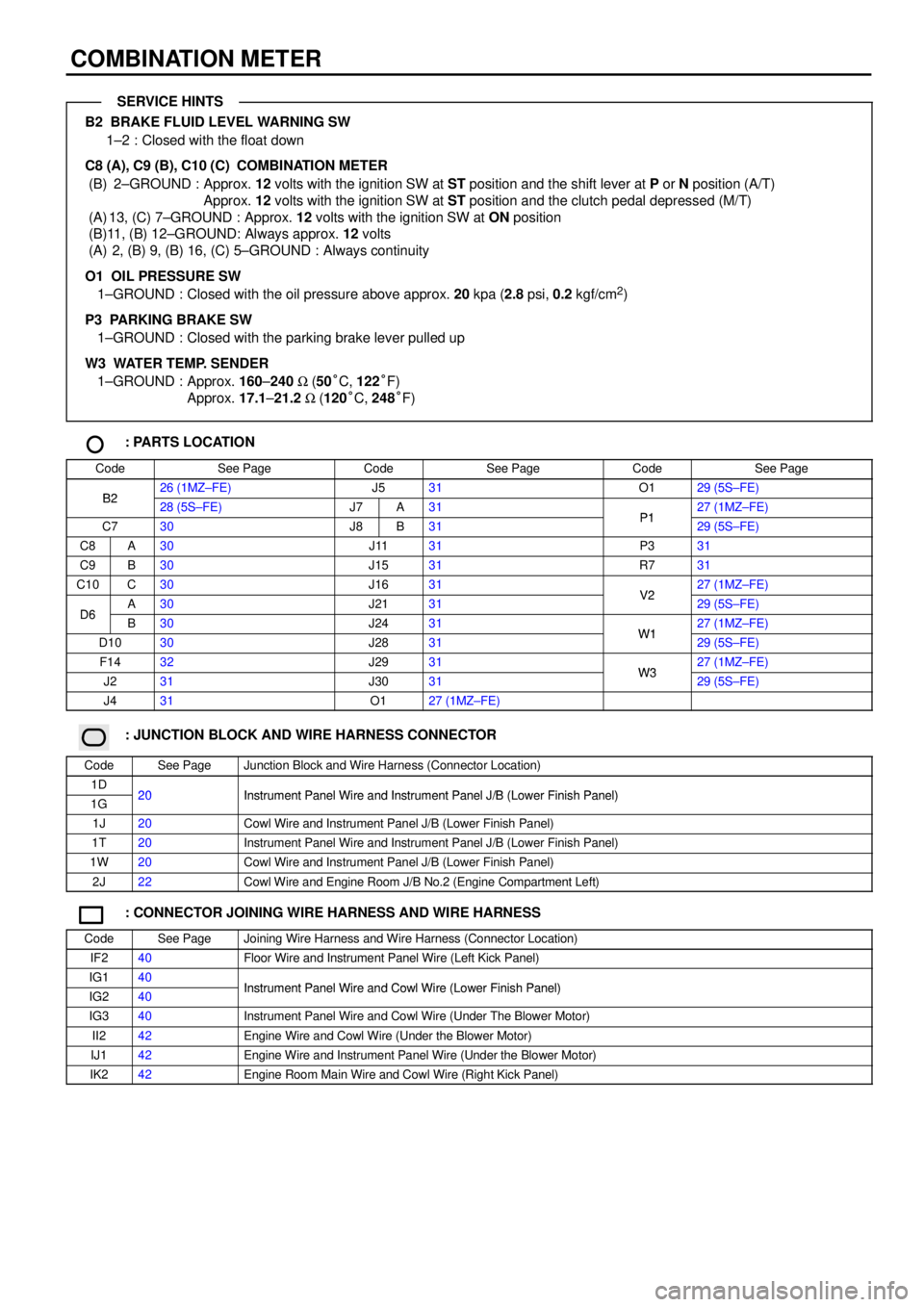
COMBINATION METER
B2 BRAKE FLUID LEVEL WARNING SW
1±2 : Closed with the float down
C8 (A), C9 (B), C10 (C)
COMBINATION METER
(B) 2±GROUND : Approx. 12 volts with the ignition SW at ST position and the shift lever at P or N position (A/T)
Approx. 12 volts with the ignition SW at ST position and the clutch pedal depressed (M/T)
(A) 13, (C) 7±GROUND : Approx. 12 volts with the ignition SW at ON position
(B)11, (B) 12±GROUND: Always approx. 12 volts
(A) 2, (B) 9, (B) 16, (C) 5±GROUND : Always continuity
O1 OIL PRESSURE SW
1±GROUND : Closed with the oil pressure above approx. 20 kpa (2.8 psi, 0.2 kgf/cm
2)
P3 PARKING BRAKE SW
1±GROUND : Closed with the parking brake lever pulled up
W3 WATER TEMP. SENDER
1±GROUND : Approx. 160±240 W (50°C, 122°F)
Approx. 17.1±21.2 W (120°C, 248°F)
: PARTS LOCATION
CodeSee PageCodeSee PageCodeSee Page
B226 (1MZ±FE)J531O129 (5S±FE)B228 (5S±FE)J7A31P127 (1MZ±FE)
C730J8B31P129 (5S±FE)
C8A30J1131P331
C9B30J1531R731
C10C30J1631V227 (1MZ±FE)
D6A30J2131V229 (5S±FE)D6B30J2431W127 (1MZ±FE)
D1030J2831W129 (5S±FE)
F1432J2931W327 (1MZ±FE)
J231J3031W329 (5S±FE)
J431O127 (1MZ±FE)
: JUNCTION BLOCK AND WIRE HARNESS CONNECTOR
CodeSee PageJunction Block and Wire Harness (Connector Location)
1D20Instrument Panel Wire and Instrument Panel J/B (Lower Finish Panel)1G20Instrument Panel Wire and Instrument Panel J/B (Lower Finish Panel)
1J20Cowl Wire and Instrument Panel J/B (Lower Finish Panel)
1T20Instrument Panel Wire and Instrument Panel J/B (Lower Finish Panel)
1W20Cowl Wire and Instrument Panel J/B (Lower Finish Panel)
2J22Cowl Wire and Engine Room J/B No.2 (Engine Compartment Left)
: CONNECTOR JOINING WIRE HARNESS AND WIRE HARNESS
CodeSee PageJoining Wire Harness and Wire Harness (Connector Location)
IF240Floor Wire and Instrument Panel Wire (Left Kick Panel)
IG140Instrument Panel Wire and Cowl Wire (Lower Finish Panel)IG240Instrument Panel Wire and Cowl Wire (Lower Finish Panel)
IG340Instrument Panel Wire and Cowl Wire (Under The Blower Motor)
II242Engine Wire and Cowl Wire (Under the Blower Motor)
IJ142Engine Wire and Instrument Panel Wire (Under the Blower Motor)
IK242Engine Room Main Wire and Cowl Wire (Right Kick Panel)
SERVICE HINTS
Page 4528 of 4592

Current always flows from the HTR fuse to TERMINAL 1 of the HTR relay. When the ignition SW is turned on, the current
from the HEATER fuse flows to TERMINAL 6 of the air vent mode control servo motor, to the MG CLT relay (Coil side) to
TERMINAL MGC of the A/C amplifier (1MZ±FE) or TERMINAL MGC of the engine control module (5S±FE), to TERMINAL 1
of the A/C dual pressure SW to TERMINAL 4 to TERMINAL +B of the A/C amplifier (1MZ±FE) or TERMINAL PRS of the
engine control module (5S±FE), current also to the HTR relay (Coil side) to TERMINAL 3 of the blower SW.
1. AIR VENT MODE CONTROL SERVO MOTOR OPERATION
When the damper is in FACE position and B/L mode on the heater control SW is selected, current flows from TERMINAL 7
of the heater control SW to TERMINAL 2 of the air vent mode control serve motor so that a signal that the ground circuit is
activated is input into TERMINAL B of the control circuit inside the air vent mode control servo motor. Simultaneously, a
signal that the ground circuit is not activated is input into TERMINAL A of the control circuit inside the servo motor. These two
signals activate the control circuit so that current flows from the HEATER fuse to the servo motor, causing the servo motor to
operate and the damper to move to B/L position. When the damper reaches B/L position. A ground cut signal is input into
TERMINAL B of the control circuit, the control circuit operates, the servo motor stops rotating and the damper stops at B/L.
When another mode position is selected, input of signals into TERMINAL A and TERMINAL B of the control circuit that
ground is made or not (as explained above) activates the control circuit and moves the serve motor to the desired position.
2. AIR CONDITIONING OPERATION
When the blower SW is on, current flows from the HEATER fuse to the HTR relay (Coil side) to TERMINAL 3 of the blower
SW to TERMINAL 1 to GROUND, activating the HTR relay. This causes current to flow from the HTR fuse to the HTR relay
(Point side) to A/C fuse to TERMINAL 2 of the A/C SW. If the A/C SW is turned on at this time, a signal is input into the A/C
amplifier (1MZ±FE) or engine control module (5S±FE). This activates the A/C amplifier (1MZ±FE) or engine control module
(5S±FE) and MG CLT relay so that current flows from the HEATER fuse to the MG CLT relay (Point side) to A/C magnetic
clutch. Causing The compressor to operate.
When blower SW is on and heater control SW is at DEF position, it causes A/C to run whether A/C SW is on or not.
HTR RELAY [R/B NO.1]
1±2 : Closed with the ignition SW on and the blower SW on
MG CLT RELAY [R/B NO.1]
5±3 : Closed with the ignition SW on, the blower SW on and the A/C SW on or the heater control SW at DEF position
A3 A/C DUAL PRESSURE SW
1±4 : Open with pressure 2.0 kgf/cm
2 (29 psi, 196 kpa) or above 32 kgf/cm2 (464 psi, 3138 kpa)
B4
BLOWER RESISTOR
6±1 : Approx. 0.62 W
1±3 : Approx. 1.46 W
2±6 : Approx. 0.38 W
: PARTS LOCATION
CodeSee PageCodeSee PageCodeSee Page
A226 (1MZ±FE)B430J831A228 (5S±FE)B530J1131
A326 (1MZ±FE)D326 (1MZ±FE)J1231A328 (5S±FE)E7A30J2331
A1230E8B30J27A31
A1330E9C30J28B31
A1430F826 (1MZ±FE)J2931
A2030F828 (5S±FE)J3231
B330H930
: RELAY BLOCKS
CodeSee PageRelay Blocks (Relay Block Location)
124Engine Room R/B No.1 (Engine Compartment Left)
SYSTEM OUTLINE
SERVICE HINTS
Page 4532 of 4592
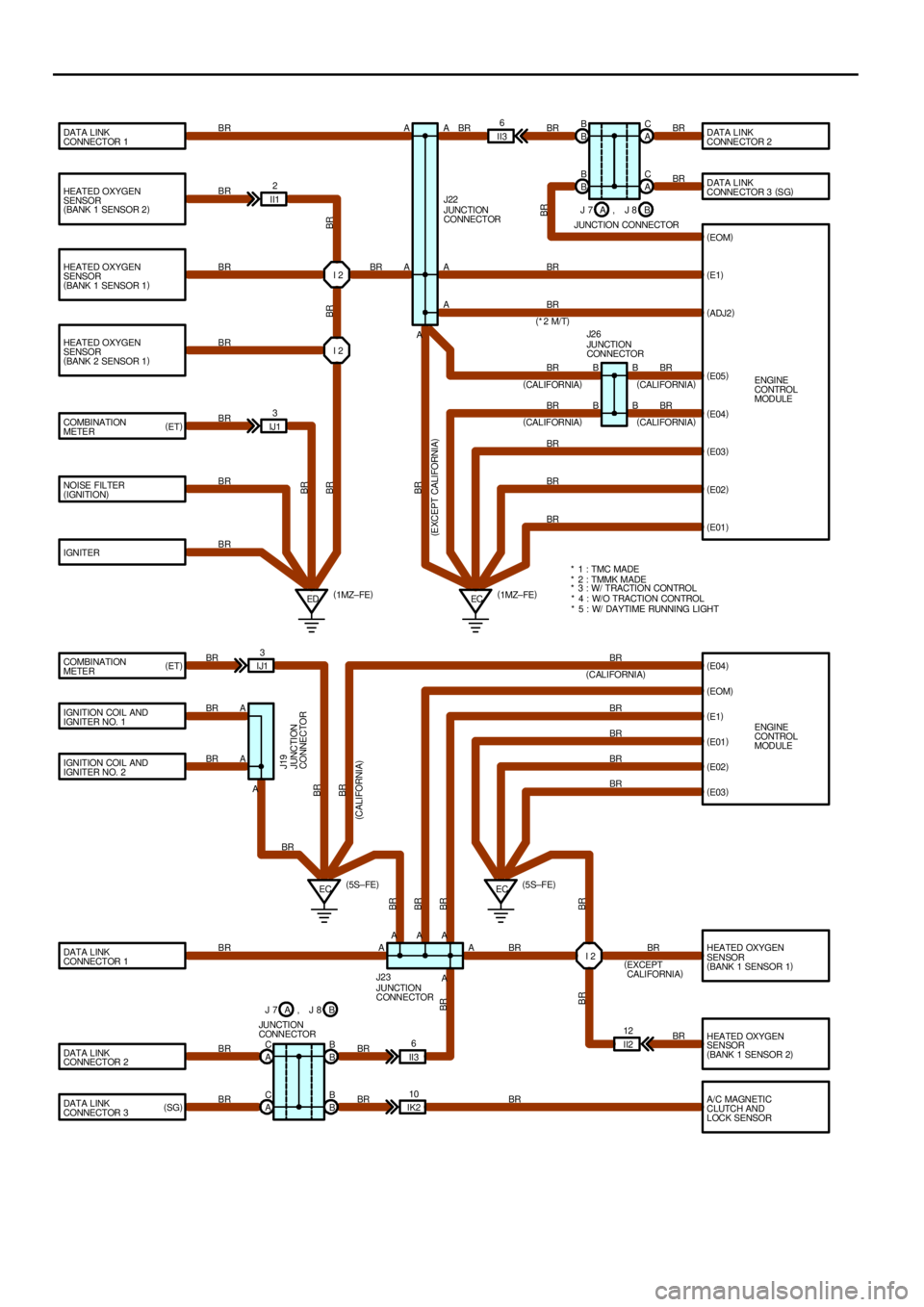
HEATED OXYGEN
SENSOR
(
BANK 1 SENSOR 2)
HEATED OXYGEN
SENSOR
(
BANK 1 SENSOR 1)
HEATED OXYGEN
SENSOR
(
BANK 2 SENSOR 1)
COMBINATION
METER
NOISE FILTER
(
IGNITION)
IGNITER DATA LINK
CONNECTOR 1DATA LINK
CONNE CTOR 2
DATA LINK
CONNE CTOR 3 (
SG)
(
E1)
(
ADJ2)
(
E03)
(
E02)
(
E01)
(
E04)
(
E1)
(
E01)
(
E02)
(
E03)
HEATED OXYGEN
SENSOR
(
BANK 1 SENSOR 1)
HEATED OXYGEN
SENSOR
(
BANK 1 SENSOR 2)
A/C MAGNETIC
CLUTCH AND
LOCK SENSOR COMBINATION
METER
IGNITION COIL AND
IGNITER NO. 1
IGNITION COIL AND
IGNITER NO. 2
DATA LINK
CONNECTOR 1
DATA LINK
CONNECTOR 2
DATA LINK
CONNECTOR 3ENGINE
CONTROL
MODULE
ED ECI 2
I 2 II12
IJ13II36
B B
A C
A C
(
1MZ± FE) (
1MZ± FE)A AA
A
A
A BR
BR
BR
BRBR
BR BR BR
BR
BR
BR
BR
BR
BR
BR
BRBR BR
BR
BRJUNCTION
CONNECTOR J22
BR
(
*2 M/T)
* 1 : TMC MADE
* 2 : TMMK MADE
* 3 : W/ TRACTION CONTROL
* 5 : W/ DAYTIME RUNNING LIGHT
ENGINE
CONTROL
MODULE IJ13
A
A
EC A
EC
I 2
II2 12
B B
B B A C
A CII36
IK210 AAA
A BR
BR
BR
BRBR
BR
BR
BR
BR
BR BR
BR
BR BR
BR BR BR BR
BR
BR BRBR BRBR
BR
(
EXCEPT
CALIFORNIA)
(
CALIFORNIA)
(
CALIFORNIA)
A (
5S±FE)(
5S±FE)
JUNCTION
CONNECTOR J19
JUNCTION
CONNECTOR J23 (
ET)
(
ET)
(
SG)B B
J 7
JUNCTION CONNECTORB A, J 8
BR
(
CALIFORNIA)
BR
(
CALIFORNIA) BR
(
CALIFORNIA)(
E05)
(
E04) J2 6
JUNCTION
CONNECTOR
(
EOM)
BR
A
J 7
JUNCTION
CONNECTORB A, J 8(
EOM)
BR
(
CALIFORNIA) BR
BR
B BB
B
* 4 : W/O TRACTION CONTROL
(
E XCEPT CALIFORNIA)